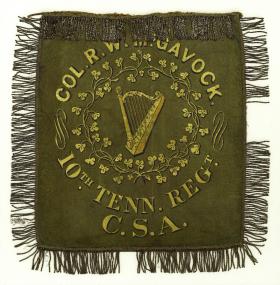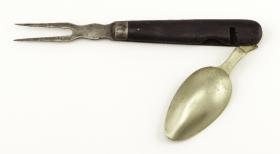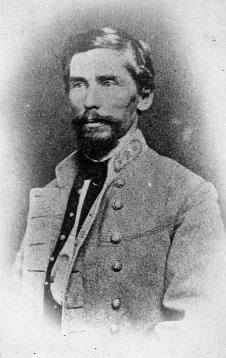Irishmen in the Confederate Army
Published in 18th–19th - Century History, Features, Issue 1 (Jan/Feb 2010), Volume 18
Guidon of McGavock’s 10th Tennessee Infantry Regiment, the only designated Irish unit in the Confederate Army.
The National Museum of Ireland’s permanent exhibition Soldiers and Chiefs: The Irish at War at Home and Abroad from 1550 has a large collection of loans from museums around the world. These include items belonging to Major General Patrick Cleburne (1828–64) and the 10th Tennessee Infantry Regiment (Irish) of the Confederate Army, on loan from the Tennessee State Museum. It is estimated that 20,000 Irish soldiers fought for the Confederate Army and 160,000 fought in the Union Army during the Civil War. While there were a number of Irish regiments, including the ‘Fighting 69th’, in the Union Army, the only Confederate regiment to be formally designated as Irish was the 10th, raised at Nashville, Tennessee, in April 1861. Under the command of Colonel Randall McGavock, an Irish-American, the regiment saw action in the Western theatre, fighting in Mississippi and Tennessee. At the Battle of Raymond, Mississippi, in May 1863, 52 members of the regiment were killed, including Colonel McGavock. On display in the exhibition is Colonel McGavock’s guidon, which would have marked his location during the battle.
Also on display are the eating utensils, military cap and walking cane of Major General Patrick
 Cleburne, who was the highest-ranking Irish-born Confederate general. Born in County Cork, Patrick Cleburne served in the British Army before purchasing his discharge and emigrating to the United States in 1849. He settled in the town of Helena, Arkansas, in 1850, first working as a pharmacist and then training as a lawyer. Cleburne proved himself an intelligent and courageous commander throughout the American Civil War and, like the 10th Regiment, fought in the Western theatre. He was dubbed the ‘Stonewall of the West’ and he was well known for advocating the contentious position of enlisting slaves in return for their freedom. General Cleburne was killed in 1864 after a disastrous frontal assault on entrenched positions against Union forces in Franklin, Tennessee. After three years on display in the Soldiers and Chiefs exhibition, the objects will be returned to Tennessee State Museum in February 2010. HI
Cleburne, who was the highest-ranking Irish-born Confederate general. Born in County Cork, Patrick Cleburne served in the British Army before purchasing his discharge and emigrating to the United States in 1849. He settled in the town of Helena, Arkansas, in 1850, first working as a pharmacist and then training as a lawyer. Cleburne proved himself an intelligent and courageous commander throughout the American Civil War and, like the 10th Regiment, fought in the Western theatre. He was dubbed the ‘Stonewall of the West’ and he was well known for advocating the contentious position of enlisting slaves in return for their freedom. General Cleburne was killed in 1864 after a disastrous frontal assault on entrenched positions against Union forces in Franklin, Tennessee. After three years on display in the Soldiers and Chiefs exhibition, the objects will be returned to Tennessee State Museum in February 2010. HI
Lar Joye is curator of military history at the National Museum of Ireland (Decorative Arts and History).

















